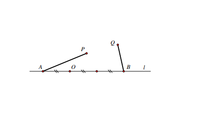Let l be a line, O be a point of l, and P, Q be two points outside l located in the same semiplane bounded by l. Determine from among all pairs of points A, B belonging to l such that O belongs to AB and | OB | = 2 | OA |, the one for which the expression | BQ | + 2 | AP | take the maximum value.

Can't solve that problem, can someone give me some clue how to solve this ? Thanks

Can't solve that problem, can someone give me some clue how to solve this ? Thanks

